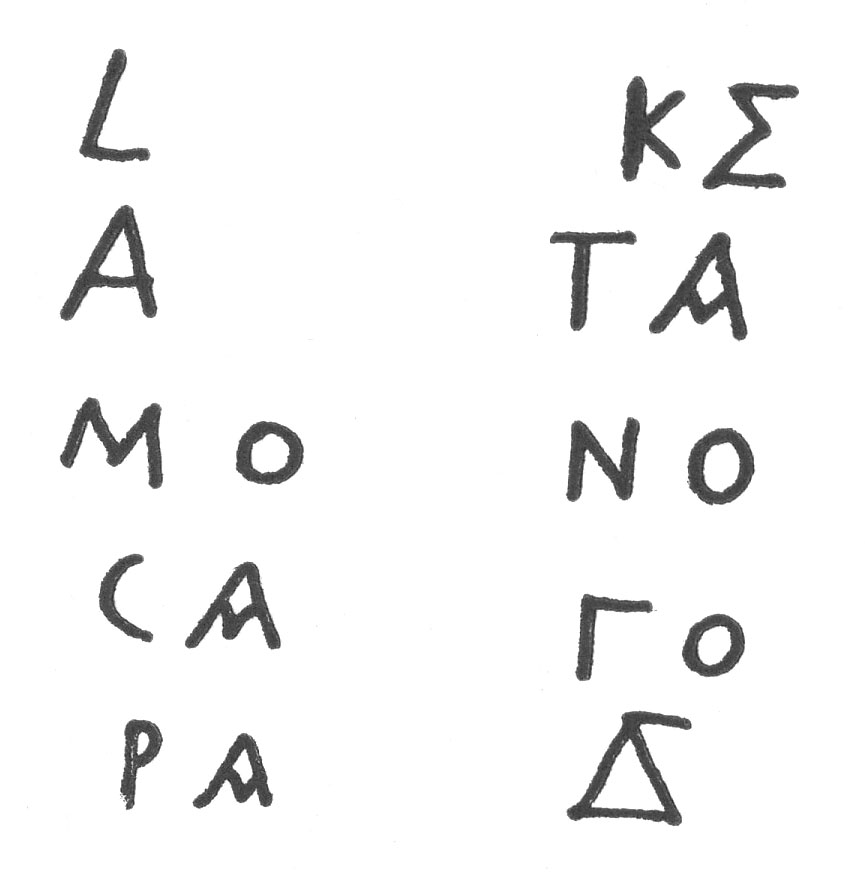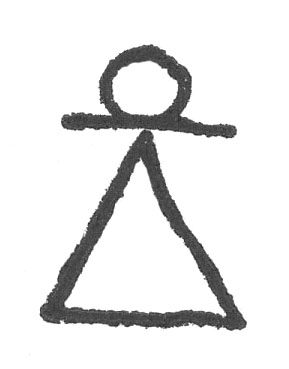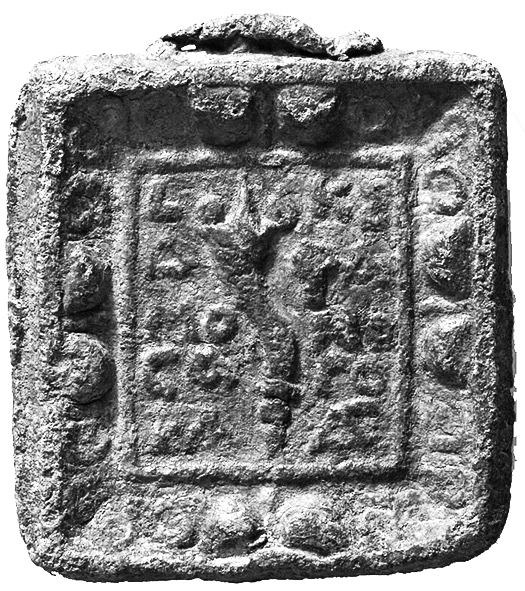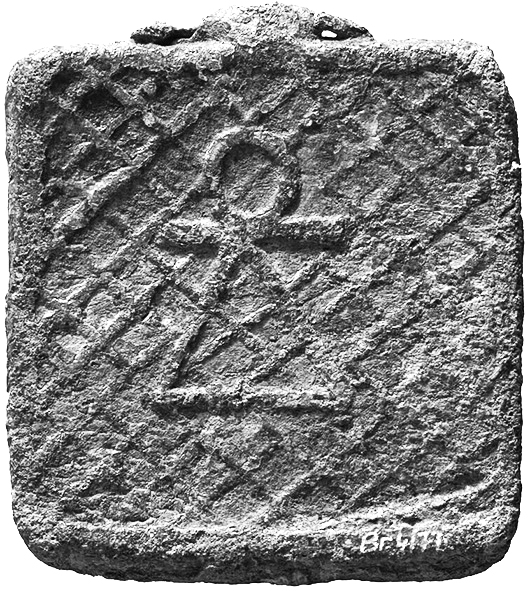
-
Copyright credit: Dain 1933

-
Copyright credit: Dain 1933

-
Copyright credit: Antoine Eid / IFPO

-
Copyright credit: Antoine Eid / IFPO

ARCHAEOLOGICAL DESCRIPTION OF THE WEIGHT
Authority
Damon, agoranomos (Berytos)
Mint
Berytos
Denomination
1/4 Mina
Material
Lead
Manufacture
Cast
Shape
Rectangle
Length
5.60 cm
Width
6.50 cm
Height
0.80 cm
Metrology
| Mass (g) | Mass (grain) | Date of measurement | Reference | fragmented | cleaned | reference weight |
|---|---|---|---|---|---|---|
| 139.00 | - | - | Seyrig Archives (HS 332, no. 11b) | No | No | No |
| 138.90 | - | Jan. 15, 2019 | Autopsy Charles Doyen | No | No | Yes |
| 138.90 | - | - | Louvre | No | No | No |
| 139.45 | - | - | Dain 1933 | No | No | No |
Iconography
| Symbol | Technique | Direction | Position | Number | Synecdoche |
|---|---|---|---|---|---|
| Cornucopia | Relief | ||||
| Egg and dart pattern | Relief | ||||
| Lattice pattern | Relief | ||||
| Sign of Tanit | Relief | ||||
| Bunch of grapes | Relief |
Wear
Corrosion
Handle
Yes
Suspension hole
Yes
Recarved mould
No
Recarved weight
No
Intentionally destroyed
No
Archaeological description
Sawaya 2023: Square lead cast weight with suspension loops squashed Dimensions: 63 × 57 × 7.5 mm (17, including the loop) and 58 mm (18). Mass: 138.9 g (17) and 149 g (18). Issued from two different molds. Preservation: very good. Dain 1933, p. 197-198, no. 237; Seyrig 1950b, p. 31, note 40; Seyrig’s archives: files HS 150-II, HS 332, and HS 337-II, no. 11; Kushnir-Stein 2005, p. 17*-18*; Finkielsztejn 2012, p. 140, note 17, no. 27. Denomination: quarter mina. Obverse: vertical cornucopia (in center), L–ΚΣ | Δ–Α | ΜΟ–ΝΟ | C Α–ΓΟ | ΡΑ– Δ– (in field), ‘Year 220, Damôn, being agoranomos, quarter mina’, all within a simple square frame surrounded by a raised border with egg-and-dart pattern. Reverse: lattice pattern with monogram {Sign of Tanit}. Agoranomos: Damôn. Findspot: findspot of no. 17 is unknown; no. 18 was found with no. 16 to the North of the Vieux Sérail at the place des Canons in Beirut. Acquisition: 17) musée du Louvre, catalogue number Br 4177, entry number MND 1423, purchased in 1925 (ex Georges Tabbagh Collection); 18) Musée national de Beyrouth, presently lost. Photographic credits: 17) musée du Louvre/Hervé Lewandowski; 18) Henri Seyrig, File HS 332, Béryte 11 (obverse photograph).
Seyrig Archives (HS 332, no. 11b): Poids carré. 58 mm. Tenon au bord supérieur. Même bordure que les précédents. Poids : a. 149 g. ; b. 139 g. Corne d’abondance. L – κσ´, | Δ–ά|μο–νο|ς ἀ–γο||ρα(νόμου), | A. Revers losangé, avec {signe de Tanit}. Date : an 220 de l’ère des Séleucides = 93/92 av. J.-C. a. Musée de Beyrouth, trouvé avec le précédent. — b. Musée du Louvre (MND 1423).
Dain 1933: Poids carré en plomb, autrefois pourvu d’une patte dont il ne reste que l’attache. À l’intérieur d’un encadrement à ornements géométriques, l’inscription, de part et d’autre d’une corne d’abondance; au revers, quadrillage et signe. Haut. Avec l’attache de la patte 0m064; côté 0m058; épaiss. 0m005; poids 139 gr. 45; lettres 0m005; interl. 0m001. L KΣ Α ΤΑ ΜΟ ΝΟ CΑ ΦΟ ΡΑ Δ = Λ κσ´ Ἀτάμονος ἀγορα Δ (“L’an 220. Atamon étant agoranome. Quart [de mine]”). Au revers, signe de Tanit. Poids daté de l’an 220, sans doute de l’ère des Seleucides, soit de l’an 92 avant J.-C.
Louvre: Poids (carré, au centre une corne d’abondance (?), inscriptions, revers avec carrés et triangle surmonté d’un cercle souligné d’une barre (partie supérieure d’une croix d’ankh).)
Seyrig Archives (HS 332, no. 11b): Poids carré. 58 mm. Tenon au bord supérieur. Même bordure que les précédents. Poids : a. 149 g. ; b. 139 g. Corne d’abondance. L – κσ´, | Δ–ά|μο–νο|ς ἀ–γο||ρα(νόμου), | A. Revers losangé, avec {signe de Tanit}. Date : an 220 de l’ère des Séleucides = 93/92 av. J.-C. a. Musée de Beyrouth, trouvé avec le précédent. — b. Musée du Louvre (MND 1423).
Dain 1933: Poids carré en plomb, autrefois pourvu d’une patte dont il ne reste que l’attache. À l’intérieur d’un encadrement à ornements géométriques, l’inscription, de part et d’autre d’une corne d’abondance; au revers, quadrillage et signe. Haut. Avec l’attache de la patte 0m064; côté 0m058; épaiss. 0m005; poids 139 gr. 45; lettres 0m005; interl. 0m001. L KΣ Α ΤΑ ΜΟ ΝΟ CΑ ΦΟ ΡΑ Δ = Λ κσ´ Ἀτάμονος ἀγορα Δ (“L’an 220. Atamon étant agoranome. Quart [de mine]”). Au revers, signe de Tanit. Poids daté de l’an 220, sans doute de l’ère des Seleucides, soit de l’an 92 avant J.-C.
Louvre: Poids (carré, au centre une corne d’abondance (?), inscriptions, revers avec carrés et triangle surmonté d’un cercle souligné d’une barre (partie supérieure d’une croix d’ankh).)
Autopsy
Yes
INSCRIPTION
| Language | Technique | Legend type |
|---|---|---|
| Greek | Relief | Authority, Date, Denomination |
Fac simile
KΣ̣
Δ Α
ΜΟ ΝΟ
ΓΟ
Ρ Δ̣´
Edition
(Ἔτους) – κσ̣´ | Δ–ά|μ⟨ω⟩–νο|ς ἀ–γο|ρα(νόμου) | (τέταρτον).
L. 2–4: Δ–ά|μο–νο|ς, Ἀτά|μονος (Dain, SEG).
L. 2–4: Δ–ά|μο–νο|ς, Ἀτά|μονος (Dain, SEG).
Monogram
ARCHAEOLOGICAL CONTEXT
Findspot (region)
Findspot (site)
context
CIRCUMSTANCES OF ACQUISITION
Region
City
Date of first acquisition
Oct. 31, 1925
circumstances
Louvre: Achat à l’Antiquaire Georges Tabbagh en octobre 1925.
DATING OF THE WEIGHT
Curatorial Section
GREEK
Time frame
FROM
-93
TO
-92
Comments on Chronology
Seleucid Era 220 = 93/92 BCE.
COLLECTION HISTORY
Collection
| Name | Date of acquisition | Inventory number |
|---|---|---|
| Louvre Museum (Paris) | Oct. 31, 1925 | Br. 4177 (MND 1423) |
Bibliography
| Reference | Page/Column | Reference (number) | Plate / Figure | Comment |
|---|---|---|---|---|
| Dain 1933 | 197–198 | 237 | None | None |
| SEG 07 | 105 | 806 | None | None |
| Seyrig 1950c | 31, n. 40 | None | None | (non vidi) (attribution to Berytos) |
| Seyrig (archives) | None | HS 332; HS 337 II; HS 338 I b; HS 338 III | None | (attribution to Berytos) |
| Kushnir-Stein 2005 | 17*–18* | None | None | None |
| SEG 55 | None | 1629, 3 | None | (non vidi) |
| Finkielsztejn 2012 | 140, n. 17 | 27 | None | None |
| Gatier 2014 | 153–154 | None | None | None |
| IGLS VIII/1 | None | None | None | None |
| Sawaya 2023 | 91–92, 111 | 17 | fig. 17 | None |
VARIA
Additional comment
L. 5: δ´ (?) = τέταρτον? See Kushnir-Stein 2005: An indication of a weight unit seems to be present also on the weight dated to the year 220 (93/2 BCE) (Dain 1933: 197-198, No. 237). It weighs 139.45 g and has a delta (Δ) at the end of the inscription; a delta would normally indicate "a quarter" ( of a mina). A short line adjoins the upper end of the delta on the right, apparently showing that the letter should be understood as a digit. The weight of the item corresponds to one fourth of the widely used Seleucid mina standard of 550-600 g.
IGLS VIII/1: L. 5. δʹ pour τέταρτον (Dain, SEG, Kushnir-Stein), αʹ (Seyrig, Finkielsztejn).
IGLS VIII/1: Provenant de « Syrie » selon A. Dain, attribué à Beyrouth par H. Seyrig (et à Tyr par G. Finkielsztejn). Julien Aliquot (personal communication): attribution to Berytos.
See https://pondera.uclouvain.be/artifact/18969/ (same types and legend); https://pondera.uclouvain.be/artifact/12069/
The “letter” that looks like a “T” or a “Φ” (l. 2) is actually a grape.
Pictures are available in Seyrig’s archives (HS 332, 337 II).
IGLS VIII/1: L. 5. δʹ pour τέταρτον (Dain, SEG, Kushnir-Stein), αʹ (Seyrig, Finkielsztejn).
IGLS VIII/1: Provenant de « Syrie » selon A. Dain, attribué à Beyrouth par H. Seyrig (et à Tyr par G. Finkielsztejn). Julien Aliquot (personal communication): attribution to Berytos.
See https://pondera.uclouvain.be/artifact/18969/ (same types and legend); https://pondera.uclouvain.be/artifact/12069/
The “letter” that looks like a “T” or a “Φ” (l. 2) is actually a grape.
Pictures are available in Seyrig’s archives (HS 332, 337 II).
Permalink
External link